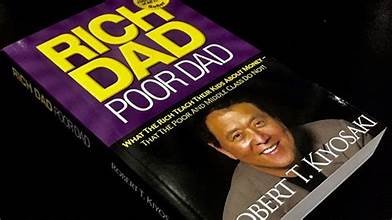“Rich Dad Poor Dad” by Robert Kiyosaki is more than just a book; it’s a financial education manual that challenges traditional views on money and investing. Published in 1997, this timeless classic has empowered millions worldwide to rethink their approach to wealth-building. Through the juxtaposition of his own “rich dad” and “poor dad,” Kiyosaki imparts invaluable lessons on financial literacy, mindset, and entrepreneurship.
The Tale of Two Dads: The heart of “Rich Dad Poor Dad” lies in the divergent teachings of the author’s two father figures. His “poor dad” represents the conventional mindset—an educated man with a stable job, living paycheck to paycheck. In contrast, his “rich dad” is an entrepreneur and investor who prioritizes financial education and asset accumulation over traditional employment.
Financial Education: Kiyosaki emphasizes the importance of financial education, arguing that the school system fails to teach vital money management skills. While his poor dad advocated for academic success leading to a secure job, his rich dad encouraged learning about money, investing, and entrepreneurship. Kiyosaki asserts that financial literacy is the key to unlocking wealth and achieving financial independence.
Mindset Shift: “Rich Dad Poor Dad” challenges readers to shift their mindset from being employees to becoming entrepreneurs and investors. It advocates for embracing risk and seeking opportunities to generate passive income. Kiyosaki stresses the significance of assets over liabilities, urging individuals to build a portfolio of income-producing investments rather than accumulating debt through liabilities like cars and houses.
The Rat Race: The concept of the “rat race” is central to Kiyosaki’s philosophy. He describes it as the endless cycle of working for money, paying expenses, and accumulating debt without ever achieving true financial freedom. Through financial education and strategic investing, Kiyosaki believes individuals can break free from this cycle and attain financial security.
Investing in Assets: One of the book’s core principles is the distinction between assets and liabilities. Assets are items that put money in your pocket, such as stocks, real estate, or business ownership, while liabilities are expenses that take money out, like mortgages or car payments. Kiyosaki advises prioritizing the acquisition of income-generating assets to build wealth and achieve financial freedom.
The Importance of Taking Action: “Rich Dad Poor Dad” emphasizes the importance of taking action and learning through experience. Kiyosaki encourages readers to overcome fear and hesitation by actively pursuing financial opportunities. Whether it’s starting a business, investing in the stock market, or acquiring real estate, he believes that taking calculated risks is essential for financial growth.
Conclusion: “Rich Dad Poor Dad” is more than just a book; it’s a roadmap to financial independence and success. By challenging conventional wisdom and offering practical advice, Robert Kiyosaki empowers readers to take control of their financial futures. Through the timeless lessons of financial education, mindset shift, and strategic investing, “Rich Dad Poor Dad” continues to inspire generations to achieve their wealth-building goals.

